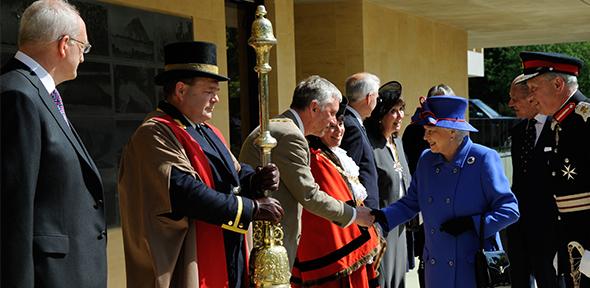
The following is a fascinating insight into the traditions and role of the Cambridge City Sergeant-at-Mace and City Crier, Chris Cracknell.
As part of the Open Cambridge weekend, Chris will be giving a talk, ‘The City charters and insignia’, on Friday 11 and Saturday 12 September between 11am – 12noon.
OC: What exactly does your role entail?
CC: My job title is Sergeant-at-Mace. I work full time in the Mayor’s Office at the Guildhall and my role is extremely varied. I’m also the City Crier; this requires me to ring the City Bell at the time of the Proclamation of both Midsummer Fair and Reach Fair. I also perform the role of Civic Toastmaster at formal dining events involving the Mayor. My day-to-day activities revolve around ensuring the Mayor gets to wherever he/she is required to be safely and on time. I drive the Mayoral vehicle and have responsibility to look after the Mayoral Chains of Office at all times when in public places. When not engaged on any of the above duties, I assist in the smooth running of the Civic and Twinning Office providing administrative support with invitations and correspondence.
OC: For those who don’t know, can you explain what maces, insignia and charters are?
CC: The Maces of Cambridge are a symbol of the Mayor’s position within the City of Cambridge and are carried with the authority of the Monarch. Our current Great Mace dates from the reign of Queen Mary in 1710. Four smaller Maces date from the reign of King George in 1724. The oldest original Charter in my possession dates from 1207 and the reign of King John, this gave Cambridge Royal consent to have a Mayor. Another gave Cambridge its own Coat of Arms and dates from 1575 and the reign of Queen Elizabeth 1.
OC: Which are the most interesting maces, insignias and charters in the collection and why?
CC: The most interesting Mace within the Guildhall is the King Charles Mace, this dates from circa 1630 and is extremely rare inasmuch as it survived the execution of Kings Charles in 1649. Once the King had been executed, the majority of Maces up and down the country (which after all are a symbol of Royal authority) were disposed of by melting down or otherwise discarded if of no material value. Our 1630 Mace was vandalised via the removal of the Crown but it still survives to this day and is displayed in the Council Chamber.
OC: Are maces still in use? If so, how and when?
CC: I bear the Great Mace whenever the reigning Monarch visits the City Of Cambridge. I have performed this role on three occasions over the last six years. I’m required to present the Mace to the Queen and turn it upside down in her presence, she acknowledges this and the Mace remains so inverted for the duration that the Queen remains on Cambridge soil. This is a visual signal to all present that Cambridge recognises that the Queen is the First Citizen of Cambridge whilst she is among us. Upon her departure, I return the Mace with the Crown uppermost and the status of First Citizen is then returned to the Mayor. The Maces are also borne on certain civic occasions such as Harvest Festival, Remembrance Sunday and Christmas Carols at Kings College. I have a number of Deputy Mace Bearers who bear our Maces as required.
OC: How do these items tell the story of Cambridge through the ages?
CC: The Charters and Maces tell the story of how Cambridge has grown from being a small rural backwater in 1207 and the arrival of our first Mayor; the arrival of the first University students in 1209 and the first College to be established in the same century (Peterhouse in 1284). Our 1575 (Coat of Arms Charter) confirms our strong links with the Royal family and recognition that, by this time, we are well-known throughout Europe as an international seat of learning. Our King Charles Mace is of historical significance as it provides a link between the struggles of the people against the Monarchy at the time of the Civil Way (1642 – 1649), our local MP was Olive Cromwell and the University was at that time very much sided with the Royalists – a real Town v Gown situation!
OC: What is the most interesting aspect of your role as Sergeant-at-Mace?
CC: Well, no two days are ever the same and added to this is the fact that the Mayor changes every 12 months so I get to work with many different characters all with their different demands and expectations.

